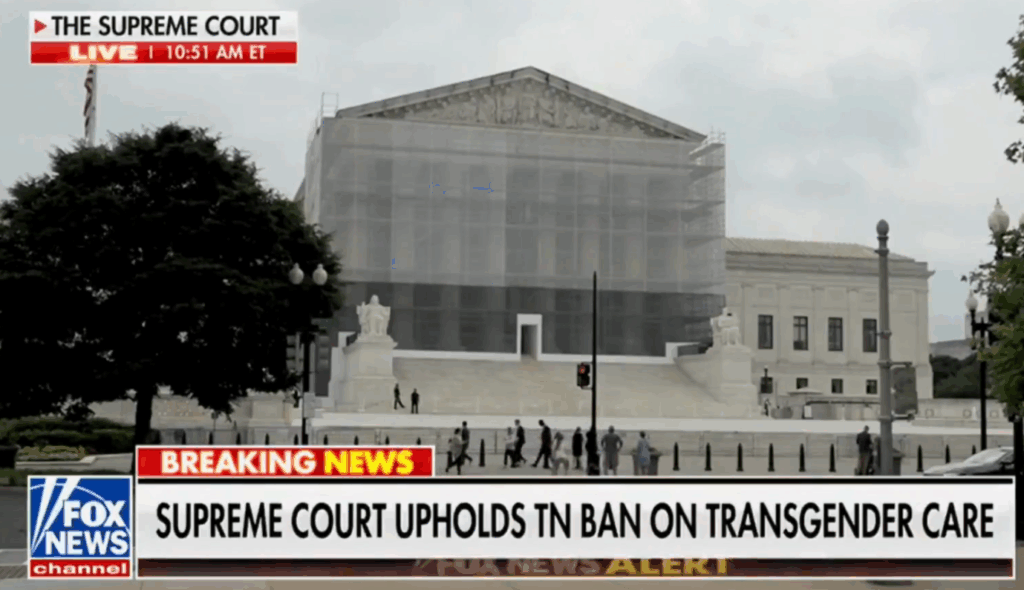
The Supreme Court faced directly the gritty details of transgenderism as it handed down its decision last week in U.S v. Skrmetti. The conservative justices used all of the arrows in their quiver, every lever in their arsenal of argument, to preserve for the people, or their elected representatives, the authority to make decisions that would bar parents from choosing gender-changing therapies and surgeries for their children. Or, on the other hand, they would preserve the same power, on the part of the people and their representatives, to sweep away any inhibitions on the freedom of parents to order those disfiguring and life-changing procedures. Chief Justice Roberts explained for the Court that the legislature in Tennessee did not rule out the freedom to administer puberty blockers or hormones to treat congenital defects or “precocious puberty” in a minor. Nor to block the ungainly growth of hair in a young girl. But the law did bar the use of procedures of this kind to treat the malady known as “gender dysphoria” or “gender identity disorder.” This was not regarded as a medical condition that warranted the dramatic remedies that a wing of the medical profession was all too ready now to supply.
What the conservative justices never quite explained, though, was just why “gender dysphoria” did not count as a legitimate medical problem that parents might be justified in delivering their children from, even with heart-breaking strain and serious hazards to be reckoned. The Court had ample data to cite about horrific procedures—mastectomies for young girls, penile implants for boys. These were surgeries that disfigured bodies, leaving children with the need for life-long medical treatment, and often rendering them sterile. The procedures offered, of course, were no sure-fire cure to the psychic torment that often led to suicide. And there was more than enough evidence that, if simply left “untreated,” with a benign neglect, children will grow out of this confusion over their sexual identity.
Chief Justice Roberts and Justice Thomas could supply a long list of those “contingent” harms that may result from the regimen of gender-altering therapies. But they still were, after all of the figures were totaled up, contingent: they could occur, or they might not occur, and the dreaded effects could be massive or mild. What was not contingent, however, at any point was the hard, objective fact that what these surgeries could never do was change a boy into a girl, or a girl into a boy. As Gerard Bradley has pleaded, with the facts as plain as they are portentous, these transgendered surgeries have “never succeed in providing any patient with the sex organs or the reproductive capacity of a member of the opposite sex. Doing that is simply impossible: no man who ‘transitions’ to female ever actually does so … These operations nonetheless invariably succeed in making anyone who undergoes them permanently sterile.” The differences that mark off males and females run down to our inner beings. “The indelible biological differences between male and female,” as he wrote, “inhabit every one of the human body’s trillions of nucleated cells. …Sex is in this most profound way indelibly imprinted upon every part of our bodies. Sex is therefore immutable.”
The truth that dares not speak its name here is that this wide array of gender-affirming therapies and surgeries is simply predicated on a falsehood. And yet those are the words that the conservative justices apparently see themselves as barred from speaking. Something in conservative jurisprudence holds them back from appealing to the inescapable and objective truth that lies at the heart of these cases. But without it, what were these accomplished jurists able to explain here? What was their ground of justification in overriding the judgments of those parents who were absorbed in the grief and confusion that seized their children? The parents of “Ryan,” one of the teenagers involved in this case, saw her getting anxious about her body, “vomiting every morning.” But after two years of therapy and the ingestion of testosterone, as Justice Sotomayor wrote, “Ryan began to find his voice again. [Sotomayor accepted the change in sex as an accomplished fact.] He started raising his hand in class, participating in school. … For Ryan’s parents, “[i]tis simply not an option to cut [him] off from this care. …I worry about his ability to survive,” Ryan’s mother attests.”
Justice Thomas held back nothing of his dubiety on the question of whether a child, or a teenager, could possibly have the maturity to make such a grave decision on life-altering surgeries. He cited one endocrinologist, who offered his sober estimate: ‘[I]t’s always a good theory that you talk about fertility preservation with a 14-year-old, but I know I’m talking to a blank wall.’” But if we summoned the tutoring of professional advice, in what would the child and the parents be instructed? Not, surely, in the question of whether the child feels with depth and sincerity the conviction that he or she is in the wrong body. As a late colleague once remarked, we don’t hear any man say, “I have a toothache—unless I’m mistaken.” No one knows better than he whether he feels the ache of that tooth. On that matter, he himself is the sovereign expert on the state of his feelings. The only “instruction” that would be relevant, Justice Thomas, is the unyielding fact that the child is in a state of confusion: he is not occupying some body apart from his own; his sex was not “assigned” at birth but marked inescapably in the organs of reproduction, in the arrangement of his body. His sex is immutable and printed plainly upon him.
Those were the words that Chief Justice Roberts and five colleagues could not move themselves to speak. Or they thought they were constrained from speaking by a jurisprudence that bars them from invoking truths beyond the text of the Constitution—even on the question of what is a human being, the bearer of rights, and when does that “human person” begin? Justice Thomas was rightly scornful of the politicized World Professional Association for Transgender Health (WPATH), with its pretentious claims to a medical “expertise.” Or to its incontinent claims of a medical “consensus” on gender-affirming care that does not exist. But to note that the families in these cases were being guided by hucksters is not to establish that the children in these cases were not suffering an acute sense of grief, or that the therapies ordered up here might have not brought them some minor relief. The truer answer to the question was that the “expertise” here was fraudulent; that it trafficked in lies; and its chief lie was about the way human beings, of necessity, must be constituted.
Without those points in place, the judgment of the Court simply dissolves into a chain of ipse dixits. Why was it not legitimate for the parents of stricken youngsters to order the procedures that might relieve their “gender dysphoria?” Answer: The legislature of Tennessee did not think it a legitimate medical remedy to choose—even though the children and the parents did not share that judgment and were willing to take their risks. One judgment had to prevail, and it was the judgment backed by the power of the State. To put a high finish on it, that “power” represented the authority of a people to govern itself through elected representatives. But when the people speak through their representatives, and override the judgments of parents about their children, they are still obliged to say something more than “we have brute the power to impose this judgment through brute enactment of the law.” Unless the Court can explain the grounds that truly compelled its judgment in this case, conservative jurisprudence falls back, as it ever has, on nothing more, as Justice Holmes had it, than the power of the majority to rule and get its way.
But even the fuller Holmes: for the opinion of the Court in this case could readily fill in as a concurring opinion for Holmes’s opinion for the Court in Buck v Bell (1927) on compulsory sterilization, surely the most reviled case now in our law books. That is where Holmes offered the gratuitous remark that “three generations of imbeciles were enough”—soaring with rhetorical dash without pausing to ask as to any evidence that Carrie Buck was even faintly imbecilic. The Court in Skrmetti offers no judgment to explain what is in principle morally wrong or unjustified with these medical therapies. What it has done is merely confirm that the people of Tennessee and their elected representatives had a tenable authority to bar parents from ordering up these disfiguring and life-altering medical procedures for their children. But with the same moral detachment they have preserved the freedom of the people in other states to sweep away any lingering inhibitions on the choice of these medical remedies. And so, in the aftermath, the Left in our politics recoils from this decision as the edict of an insufferably conservative Court, and they double down in their defense of these therapies as “gender-affirming” care. All that the Court has established, as conservative jurisprudence has it, is the right of the majority to rule—unless of course the text of Constitution explicitly contains a “right” that majority is not free to abridge. But the text of the Constitution contains no such right to order or bar these surgeries to change sex, as it contains no right of people to be spared from compulsory sterilization. And with those barriers cleared away, the judges can take up their vocation as Holmes had it, to let the majority have its way: “I always say…that if my fellow citizens want to go to Hell I will help them. It’s my job.”
We should recall that Holmes’s grand opinion quickly drew the accolades of the academy and the educated class, quite as enthralled with the romance of euthanasia, as their latter-day counterparts have been about climate change. And all of the ingredients are now again in place: a “controversial medical” procedure, along with people with medical degrees more than eager to show just how they do it; and the case for it seems compelling enough to be enacted into law by those educated people, often with law degrees, who fill out the legislature. But might we not be forgiven for asking: Is this the best that conservative jurisprudence can really serve up now, a concurring opinion in Buck v Bell?


